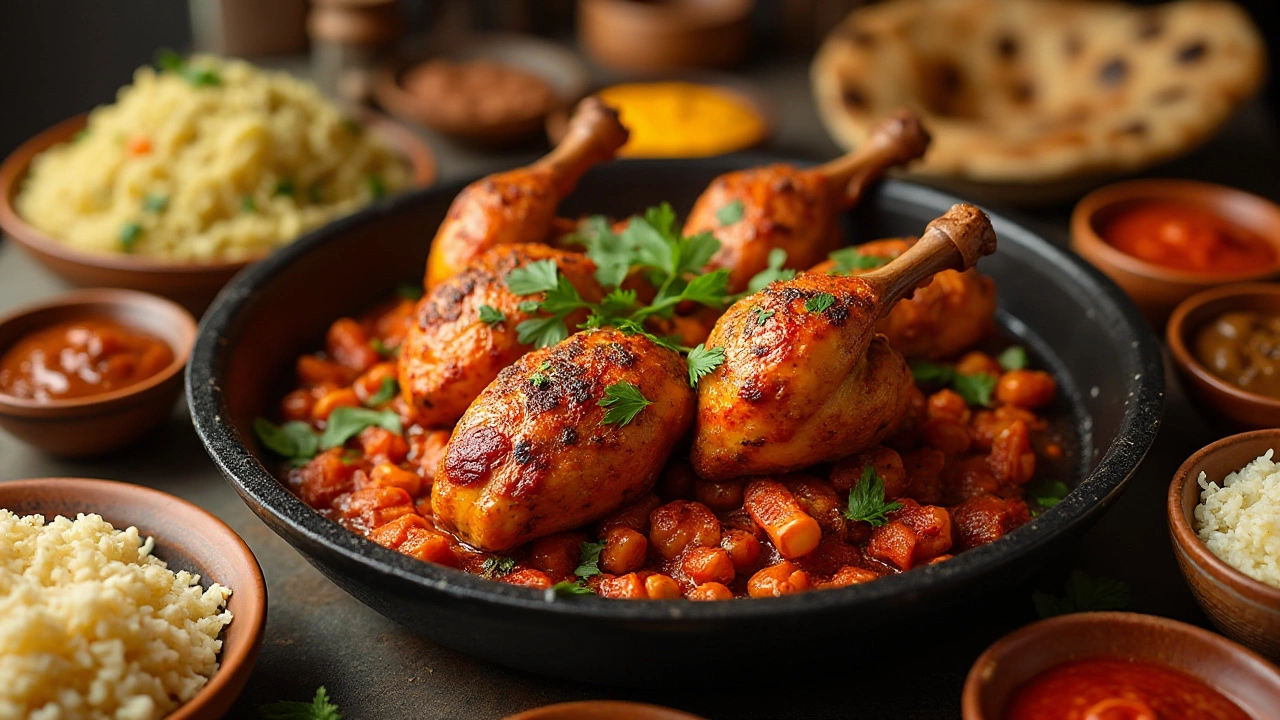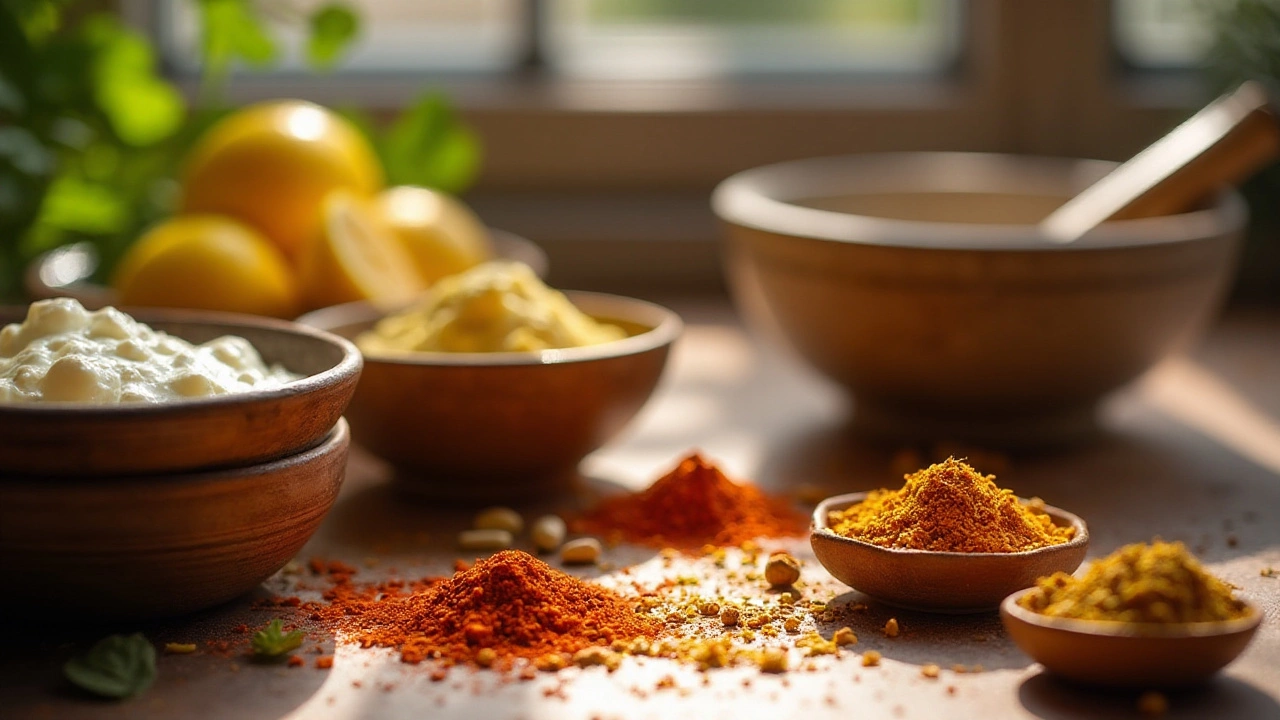Tandoori chicken sauce—a name that conjures up images of smoky grills and vibrant Indian spices. This sauce isn't just a culinary complement; it's an experience marked by aromatic bliss and rich tradition. Whether you're a seasoned chef or a home cook exploring new horizons, understanding the foundations of this sauce is key to creating a tandoori chicken that stands out.
Dive into the aromatic world of Indian cuisine and discover the essential ingredients and techniques that make tandoori chicken sauce irresistible.
- Origins of Tandoori Chicken Sauce
- Essential Ingredients
- Traditional Spice Blend
- Marination Tips
- Homemade Tandoori Chicken Sauce Recipe
Origins of Tandoori Chicken Sauce
The journey of tandoori chicken and its iconic sauce begins deep in the heart of Northern India, a region renowned for its vibrant culinary traditions. It all melded into existence over a thousand years ago with the advent of the tandoor, a cylindrical clay oven unique to the Indian subcontinent. The distinctive cooking method harnesses the intense heat from burning charcoal or wood. This isn't just about cooking—it’s about imbuing the meat with a smoky flavor that's distinctively Indian. Legend has it that the modern version of the dish as we know it today was popularized in the 1920s by Kundan Lal Gujral in Peshawar. This tale marks an evolution from the simple practices of roasting meat to a celebrated delicacy embraced worldwide.
The Indian cuisine was predicated upon a rich tapestry of flavors and overtones, yet the magic of tandoori chicken lies in its sauce—a marinade that transforms. Its base compound of yogurt influences every bite, tenderizing the chicken while maintaining its moisture amidst high temperatures. But it’s the array of spices and their meticulous blend which gives tandoori its soul. A harmonious marriage of cumin, coriander, turmeric, and other local spices creates a flavor profile that dances across the palate. To understand the origins of this sauce is to understand a symphony of flavors, a balance between aromatic spices, the creamy tang of yogurt, and the zest of lemon.
"The taste of India is brilliantly captured in the aroma of tandoori," noted Madhur Jaffrey, a famed Indian food writer, capturing its essence in mere words.
Tandoori sauce isn’t just reserved for chicken. Various regions across India have cultivated their own iterations, each embedding local taste preferences into the marinade, influencing the foundational spice blend. From Kashmir's use of saffron to the spicy touch in Andhra Pradesh, every province brings something unique. These nuances find their way into the coherent tradition of Indian cooking. The best recipes highlight subtle differences while maintaining the authenticity rooted in tradition. Over time, chefs worldwide have adapted the sauce with their own enhancements while remaining true to its essence.
Beyond its taste, tandoori chicken sauce has cultural significance, symbolizing warmth, hospitality, and vibrant community feasts. It’s shared over celebrations, resonating with the chatter of lively gatherings—a common thread running through Indian social fabric. As the sauce continues to transcend geographical boundaries, it remains a powerful metaphor for the growing global affinity for Indian flavors. Its story is one of evolution yet stable tradition, a culinary mainstay that captures the endless spirit of innovation found in the kitchens of the world over.
Essential Ingredients
Creating the perfect tandoori chicken sauce is akin to painting with a vibrant palette of flavors. The ingredients used in this marination mix are celebrated for their ability to transform ordinary chicken into a succulent, tasty feast. At the heart of this concoction is yogurt, an ingredient not just valued for its tangy flair but also for its functional role in tenderizing the meat. The yogurt creates a creamy base allowing the spices to envelop each piece of chicken thoroughly, ensuring every bite bursts with flavor. The second cornerstone of the sauce is lemon juice, which adds a refreshing tang and aids in the absorption of the marinade into the chicken. The citrusy note enhances the blend, adding complexity to the dish.
Spices are the soul of the tandoori chicken sauce, giving it the characteristic bold color and distinctive aroma. A combination of cumin, coriander, and garam masala serves as the traditional spice mix, offering layers of warmth and earthiness. Cumin is known for its nutty aroma and peppery hints, providing a subtle depth. Coriander on the other hand adds a slight citrusy tone, while garam masala, a complex blend itself, brings together warming spices like cinnamon and cloves. Each spice adds a unique dimension, creating a balanced and harmonious flavor profile. Interestingly, it is said that a well-proportioned garam masala blend can distinguish a good tandoori chicken from an exceptional one.
Turmeric, a spice renowned for its vibrant color, adds an inviting hue that is intrinsic to the visual appeal of tandoori dishes. Not only does turmeric give the sauce a golden glow, but it also offers subtle mustard-like earthiness. To round off the flavors with a hint of sweetness, some recipes incorporate a spoonful of honey or maple syrup. This addition balances the acidity and spice, heightening the overall taste experience. According to a traditional chef, "The secret to an unforgettable tandoori sauce is the harmony between the spicy, the tangy, and the subtly sweet."
A pinch of chili powder or cayenne pepper can elevate the heat profile, providing that signature fiery kick characteristic of Indian cuisine. Adjusting the level of spice to suit personal taste is common practice, allowing each cook to tailor the recipe to their liking. Meanwhile, freshly grated ginger and garlic offer complex flavors that tie the sauce together. These ingredients are not just admired for their taste, but also for their myriad health benefits, from anti-inflammatory properties to aiding digestion.
Optionally, some chefs might add a touch of ground cardamom or nutmeg to introduce an exotic hint of sweetness and warmth. These exotic spices might not be in every tandoori recipe, but they can certainly elevate the sauce to new heights of flavor sophistication. For those looking to add an extra pop of color, a sprinkle of paprika is a popular choice—they say it deepens the red hue without overwhelming the senses.
All these ingredients together form an irresistible marinade that distinctly marks this dish as a classic of Indian culinary tradition. While it might seem daunting to bring together so many components, understanding the role each ingredient plays will help craft the perfect tandoori chicken sauce every time.

Traditional Spice Blend
The heart of any great tandoori chicken lies in its traditional spice blend. These spices are much more than mere ingredients; they represent a tapestry of Indian culinary traditions and flavors, weaving together to create a symphony of taste. The blend is both an art and a science, encapsulating history in every sprinkle. Typical spice mixes for tandoori chicken include cumin, which adds a warm, earthy flavor, and coriander, known for its light and citrusy notes. These are often combined with the fiery warmth of cayenne pepper or paprika, depending on the desired level of heat. Some secret family recipes also incorporate a hint of clove and cardamom to deepen the complexity and aroma.
Garlic and ginger are indispensable, not only for the flavors they impart but also for their tenderizing properties, allowing the chicken to soak in the marinade more effectively. Turmeric imparts its vibrant yellow color, which, combined with the red of paprika, gives tandoori chicken its signature hue. As for the salt, black salt is sometimes preferred for its distinctive taste. You can almost imagine the generations of cooks, with their spice grinders and mortar pestles, debating the perfect ratios while standing over a clay oven. As renowned chef Madhur Jaffrey once noted,
"The right balance of spices can make mediocre ingredients into something truly spectacular."
The blending of these spices is very crucial. They must be freshly ground for the fullest flavor and then roasted lightly in a dry pan to release their essential oils, a process that enhances both aroma and taste. Interestingly, many experienced chefs swear by subtly varying proportion each time to account for the freshness of the spices and the dish it complements. This spice mix can be used in multiple dishes, but it holds a special place in tandoori chicken for its transformative power. When combined with yogurt, this mixture not only envelops the chicken but penetrates its very essence, creating a symphony of flavors that dance across the palate. Handy for home cooks, this blend can be made in bulk and stored in an airtight jar, lasting for weeks while preserving its pungent charm. Embrace this art, and let it inspire you in your kitchen adventures.
Marination Tips
When it comes to crafting the perfect tandoori chicken, mastering the art of marination is essential. This crucial step infuses the chicken with flavor, creating that irresistible taste that tandoori is famous for. The key lies in balancing the ingredients to ensure each piece of chicken is enveloped in a medley of spices and tenderizing agents. Traditionally, the process begins with a base of creamy yogurt. The yogurt acts not only as a thickening agent but also as a tenderizer, soaking into the meat to guarantee juiciness. Make sure to keep the consistency smooth and avoid using watery yogurt, as it can dilute the flavors. Fresh lemon juice is another staple ingredient that adds a tangy twist, its citric acid ensuring that the chicken remains tender while contributing to the overall flavor profile.
Integrating a well-balanced spice mix, often referred to as 'masala', is what sets apart one marination from another. Your spice rack should include a bold lineup of Indian cuisine essentials like cumin, coriander, and garam masala, which should be used generously based on personal flavor preferences. Each spice brings its unique aroma and depth, mingling together as they penetrate the chicken. It's essential to massage these spices into the meat thoroughly, ensuring that every bite bursts with the full spectrum of flavors. To add a fiery kick, you might include a pinch of red chili powder, while smoked paprika can add a subtle smokiness that pairs beautifully with the grilling process.
"The secret to a remarkable tandoori marinade lies in the patience of preparation. Give your chicken the time to soak in all the flavors, and it will reward you with each succulent bite." — Chef Ayesha Dharker
An often overlooked element of successful marination is timing. Allowing the chicken to marinate for at least 6 to 8 hours, or overnight if possible, is vital. This gives enough time for flavors to meld and for the enzymes in the yogurt and lemon to work their magic in tenderizing the meat. Refrigerate the marinating chicken and make sure it's covered to maintain moisture and prevent any unwanted flavors from your fridge from seeping into the dish. As you prepare, keep in mind the climate conditions in your kitchen; particularly warm environments may necessitate adjustments in marination time to prevent spoilage.
It's equally important to note the size and cuts of the chicken. Smaller, uniform pieces ensure even absorption of the marinade, while larger pieces may require a more extended marination period. A sharp knife will be your best ally in scoring the chicken lightly, allowing the marinade to penetrate deeper into the flesh. Once the marination period is over, it's time to bring your chicken to room temperature before cooking, which helps it cook more evenly across the grill. As a final touch, an optional dusting of additional spice just before cooking can enhance flavors, adding a final layer of zest to your tandoori chicken.

Homemade Tandoori Chicken Sauce Recipe
Creating your own tandoori chicken sauce at home opens up a world of vibrant flavors, allowing you to enjoy a beloved dish at its freshest. While many might think it involves a complex mix, the magic lies in a few key ingredients blended to perfection. Begin with a base of thick yogurt, which acts as both a tenderizer and a carrier of flavors. The yogurt also contributes to the sauce's rich consistency, helping the spices adhere better to the chicken. Add freshly squeezed lemon juice for a zesty kick, balancing the depth of the yogurt with a tangy note.
The heart of the sauce is undoubtedly its spice blend. Here is where the alchemy happens. You'll need a combination of classic spices such as cumin, coriander, and garam masala. These spices bring warmth and a beautifully complex aroma that can transport you straight to an Indian street market bustling with life. Not just for spice aficionado satisfaction, these elements play a critical role in the traditional seasoning of tandoori chicken. For an authentic earthy aroma, don't forget the smoked paprika, and a pinch of cayenne for those perfect heat notes.
With ingredients ready, you can move on to the creation of this delightful marinade. Combine the yogurt, lemon juice, and spices in a bowl, mixing until smooth. Use a spoon or a whisk, ensuring each spice is distributed evenly. The key here is patience—you want the ingredients to marry and form a beautiful harmony. Once the sauce is uniform, it’s time to marinate the chicken. Immerse the pieces in this delightful neon-tinged concoction, letting it infuse for at least four hours, although overnight is ideal for the most flavorful result.
For an exceptional marinade, adhere to this simple yet effective process. The waiting ensures that the chicken marinade penetrates deeply, offering a rich taste that remains throughout cooking. Preheat your oven or grill, and cook the marinated chicken until it is tender and juicy, with a distinct, smoky flavor that typifies traditional tandoori chicken. It's crucial not to rush this process—let the heat work its magic slowly. For those without a tandoor oven, a preheated grill or convection oven will offer superb results, exuding an irresistible aroma that fills your kitchen with a promise of exotica.
Judiciously crafted and lovingly made, tandoori chicken sauce will showcase your culinary prowess and bring warmth to any meal. Reflect on culinary wisdom during preparation, and remember what Madhur Jaffrey once said:
The best recipes are those that don’t just create good food but good memories.
Let this recipe help create lasting memories at your table with delicious, homemade tandoori chicken. Try adding a dash more paprika if you want extra vibrance, or adjust the heat by varying the amount of cayenne—make it your own. As you master this sauce, the potential to explore and adapt it according to personal taste is limitless—a mark of a true culinary artist's spirit.
